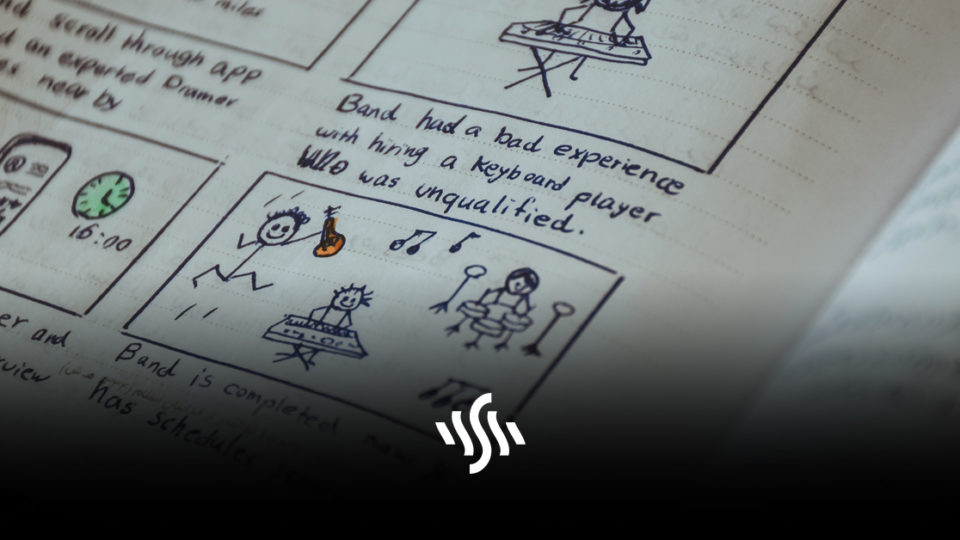What Is Storyboarding & How Do You Craft One?
Whether you’re creating a short film, a music video, or even an animated sequence, storyboarding is an essential tool in visual storytelling. Here, we’ll explore the idea behind storyboards, why they’re important and offer practical tips on creating your own effective storyboard.
Understanding Storyboarding
Storyboarding is a visual roadmap that helps you plan and organise your video content before shooting or animating. It involves creating a sequence of sketches or illustrations that represent the key moments of your story, shot by shot.
This technique allows you to visualise your ideas, identify potential issues, and make necessary adjustments before investing time and resources into production.
A storyboard also serves as a visual blueprint that communicates your vision to your team. This could include directors, cinematographers, animators, and editors. It helps align everyone’s creative vision and ensures a smooth and efficient production process.
Benefits & Advantages of a Storyboard
We’ve already touched upon some of the benefits of creating a storyboard in the above section. Entering into a creative project can feel a little like making sense of chaos. This is especially true if you’re trying to relay your vision to other people.
Here are some more advantages to making storyboards, that will reduce so much stress around your content creation projects.
- Visualisation: Storyboarding helps you see your story come to life before filming, enabling you to identify gaps, inconsistencies, or opportunities for improvement.
- Efficient Communication: Sharing your storyboard with your team allows for clear communication and ensures everyone is on the same page regarding the visual direction of the project.
- Time and Cost Savings: By storyboarding, you can highlight potential issues, revise your ideas, and make changes early on. As a result, you can save lots of time and money during production.
- Collaboration: Storyboarding boosts teamwork by providing a common visual language for the entire team to understand and contribute to the creative process.

Practical Tips for Crafting an Effective Storyboard
There’s no set-in-stone way to create a useful storyboard. After all, it’s just a series of images representing a frame or idea. If you’ve never had a go at storyboarding, experiment with different techniques. Eventually, you’ll find a method that suits you best.
Regardless of how you choose to storyboard, here are some handy hints to get you started!
- Start with a Script: Develop a detailed script or outline for your video content. This serves as the base for your storyboard, allowing you to break down the scenes into individual shots.
- Sketching Techniques: You don’t need to be an artist to create a storyboard. Use simple sketches or stick figures to represent the key elements of each shot. Focus on capturing the composition, camera angles, character positions, and important objects or actions.
- Shot Descriptions: Alongside your sketches, include shot descriptions that provide additional details about each shot. These can include camera movements, framing, visual effects, and any important dialogue or sound cues.
- Sequential Flow: Arrange your storyboard panels in a logical sequence, reflecting the narrative flow of your story. This helps you maintain a coherent and engaging visual progression throughout your video content.
- Annotations and Notes: Use arrows, captions, or annotations to provide additional information about transitions, visual effects, lighting, and other important details. These notes help convey your creative vision more effectively.
Tools and Resources for Storyboarding
Luckily, there are lots of digital tools available to simplify the storyboarding process. This means life can be made easier for you independent content creators and filmmakers. Here are a few popular options:
- Storyboarder: A free, user-friendly software that allows you to create digital storyboards, add annotations, and export them in various formats.
- Adobe Creative Cloud: Offers professional tools like Adobe Photoshop and Adobe Illustrator that enable you to create high-quality digital storyboards.
- Mobile Apps: Explore mobile apps such as ShotPro or Boords that offer intuitive interfaces and features designed specifically for storyboarding on the go.
Summing Up
Storyboarding is a powerful technique that empowers independent content creators and filmmakers to bring their creative visions to life. It is a vital tool that visualises your ideas, improves communication, and saves time and money.
Don’t worry about creating a masterpiece in your storyboard. The point is to get your ideas onto paper or the screen. Simplicity is your friend, but be sure to focus on the key essence of each shot. Just grab a pen and paper, or a digital tool, and start storyboarding your next project!
Don’t forget the music when creating your storyboard!
Synchedin offers a huge range of high-quality royalty free music that you can use in your content projects.
Sign up today, and find the perfect song for your next project.
